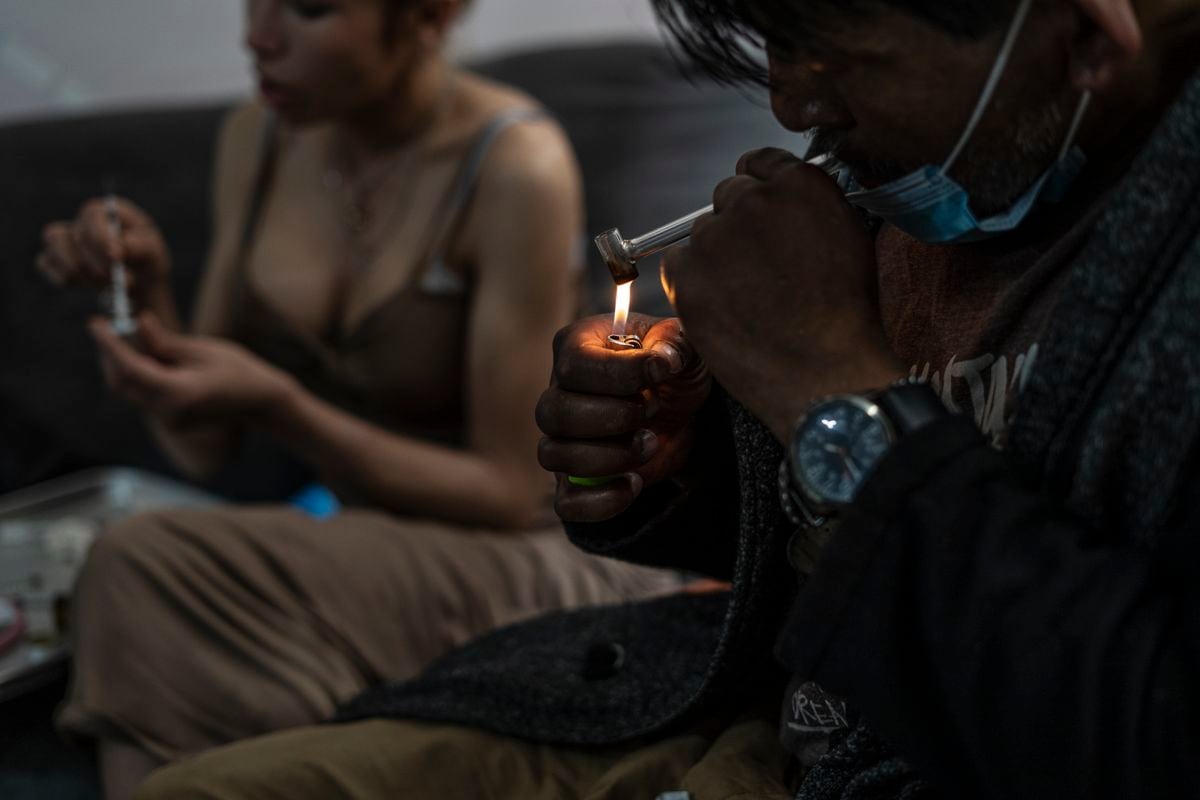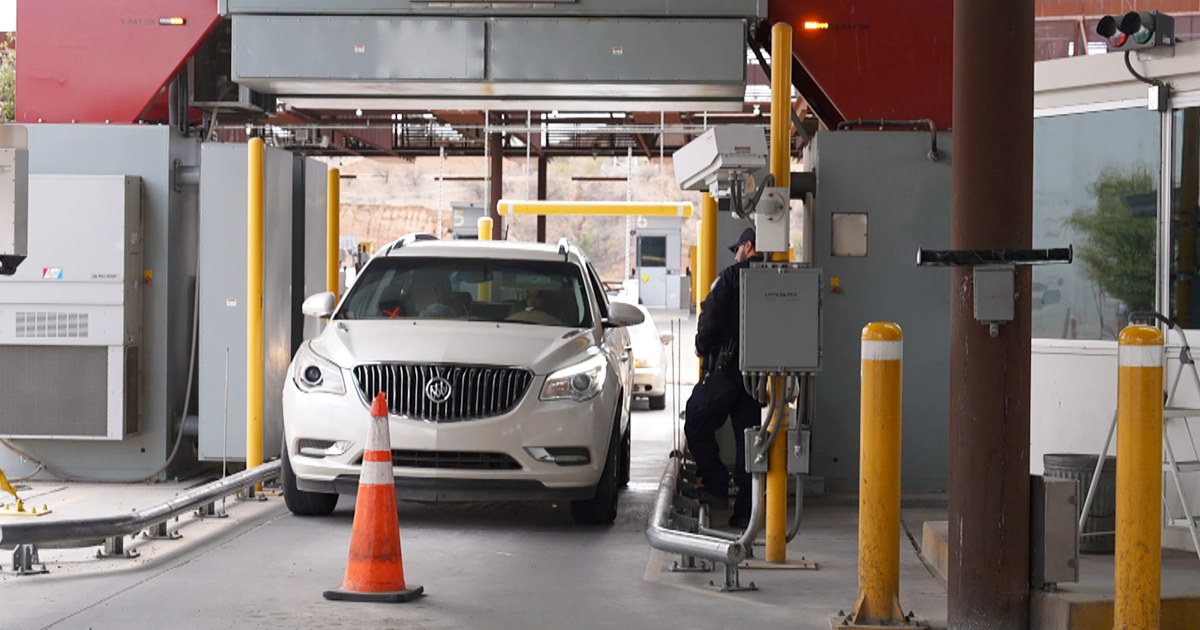His left arm hangs inertly to one side. The police split Hugo Arroyo in two as he slept on the streets of Tijuana; He says that he went to sticks, that he did not get up in time. Three years have passed and he is still waiting, patiently, for an operation to fix it. Meanwhile, he sweeps, scrubs, prunes the trees, takes out the garbage, waters, screws, composes what decomposes, with one arm: he has already become accustomed to doing his job like this, but the pain is something else. "I think that because of fentanyl I have endured my arm, have it broken and go around pretending to have nothing," he says with a shy smile, "the doctor asked me if I was sure I wanted to operate because that hurt very much, I told him that because more pain I do not think it is. " Arroyo consumes fentanyl daily, like hundreds of others along this border. In the United States, this brutal and elusive drug, 50 times more potent than heroin, is behind 100,000 deaths each year. There is no official data on the impact in Mexico, but experts and organizations insist: with it comes the next great public health crisis in the country.
Fentanyl seems like a legend, a story to scare children. Lethal, but very cheap, you can get a dose for about 2.5 dollars; hooks just by trying it a few times, three says Uriel, also three says Mari. Once inside, it does not let go. The effect, the rush, lasts little and the malilla, as they call the withdrawal syndrome here, spreads quickly: the bones hurt as if it were a flu, the head as if it were migraine, the stomach as if it were gastroenteritis. The reaction of the body without the drug is fierce.
Fentanyl is smoked, inhaled, injected. How many times? Those who try to gain time, turn three times a day into an example of willpower, others can reach 10 punctures, also lose count. One of the few government polls put the average at seven. Those who use it have turned their life into a race against the next dose.
Hugo Arroyo, in the courtyard of the organization Prevencasa, in Tijuana (Mexico). Gladys Serrano
"What hurts me the most, what weighs me the most, is having to get up in the morning and having to use fentanyl, forcibly, because otherwise I can't do anything. The bones hurt, the mind doesn't stop thinking about it, I don't concentrate. If I don't use it, I can't do anything," said Arroyo, 53. His story is that of many. Born in Uruapan, Michoacán, poverty made him cross into the United States, trying three times until he settled in California. He worked in a factory and dishwasher. "I climbed up to cook," he says proudly. He got together, had a son. Life went on. After 20 years in the United States, he was expelled for driving while drinking alcohol. It was the third time, he was imprisoned and returned in 2013 to a country he no longer knew. Since then: the spiral.
He got hooked on heroin and then therapies, methadone, rehab centers to get out of it. He got it once. He worked with a company collecting garbage in the Plaza Rio in Tijuana and decided to pause and go inside. He came out after three months, clean. He got his job back and endured a year without consuming until the company went bankrupt. "They owed me six months. That breaks your floor: suddenly I found myself without a weight, without a place to sleep, "says this kind man with big eyes sadly. Already on the street he reached fentanyl: "The effect was like that of heroin but much stronger. The amount I had to use was less, it cost me less money." After the episode with the police, he was received for medical attention at the Prevencasa organization in 2019. They have given him a room to live in and a small maintenance job in the center. "Because I'm here and I have things to do, I don't feel as pressured to do it again. Out there it was dose after dose, one after another."
A city turned into a laboratory
Just a few meters from the wall that separates Mexico and the United States, Prevencasa's patio has become an oasis in Tijuana. In this free center, specialized in harm reduction, those who take drugs receive information and medical attention, clean water, a shower, psychological treatment and also new syringes, to avoid contagion and infections. In this city of two heads, which speaks English and Spanish, in which pesos and dollars are distributed, consumers have become invisible; Homeless, bent or lying in the middle of the street, they are part of the urban landscape. The city is rife with rehabilitation clinics, mostly private, and religious organizations that offer the famous 12-step method. At the same time, drug trafficking groups are perfecting substances: more addictive, more available.
Experts no longer have any doubt that Tijuana and its consumers have been used as guinea pigs for fentanyl. "Tijuana and Ciudad Juárez have functioned as a laboratory, to specify combinations, doses, on how to try to put fentanyl in other drugs," says José Andrés Sumano, a researcher on drug trafficking and public security at the Colegio de la Frontera Norte (Colef). Tijuana is one of the world's busiest borders and the epicenter of fentanyl seizures in Mexico for years, according to reports from Mexican authorities.
A group of drug users on May 10, in Tijuana, Baja California, Mexico.Gladys Serrano
The trail of this drug is international. Most of its precursors – the molecules that serve to create it – leave China and India, arrive in Mexico through their ports or through Guatemala, and here they are cooked, assembled and sent north to the United States and Canada, the largest consumers in the world. At its final destination, fentanyl is not generally being demanded on its own, but the cartels have bundled it in between cocaine, heroin and crystal. The question is repeated: why?
"It is convenient for them to do it because it is much more profitable, unlike cocaine that they have to go to produce in the mountains of Colombia or heroin, which have to go through opium and have large plantations, fentanyl is produced in a simple, small laboratory, with few chemical precursors, they do not require large facilities. Such is their potency that with a little active ingredient they can make a lot of product. It is highly profitable, they make much more money with fentanyl than with cocaine or heroin," explains José Andrés Sumano.
Fentanyl has thus become a kind of goose that lays the golden eggs for drug traffickers, which also allows them to sell it much cheaper: the production is less expensive and the risks are lower, they can also transport less product because it generates much greater effect. Behind that simple premise are hidden the 200 deaths a day in the US by fentanyl. A large part of those affected were using cocaine or crystal in their usual doses in which, without their knowledge, there was fentanyl. "Organized crime has been learning, it has not had a very clear control of the doses, they send in mixed fentanyl, but without precision," says the Colef researcher.
Trial and error has proved lethal. In the United States, but also on this side of the border, where a large part of the adjustment experiments were carried out among the most vulnerable population. "Between 2017 and 2018, we began to see effects on user behavior seconds after administration: episodes of psychosis, hallucinations. It seemed strange to us, because it didn't happen with tar. That was only in the beginning, then it is as if some adaptation had been made, "says Lilia Pacheco, general coordinator of projects at Prevencasa. "The other thing we see as worrisome is overdoses," he says. The organization usually attends two or three overdoses daily. José Andrés Sumano puts a figure: they have grown between 200% and 400% in recent years.
Karen prepares a dose of heroin with fentanyl. Gladys Serrano
Karen no longer keeps track of how many she's had since she started using fentanyl directly in 2020. Is it 12? Is it 15? She was a student of Psychopedagogy in Guadalajara (Jalisco) when she tried the drug with an ex-boyfriend. "It was when I first took fentanyl that I died. It was like five droplets through my nose, which are the ones I didn't resist, and then they revived me. I was 24 years old," he says.
After that time many followed, he remembers few but the first loaded injection: "I turned purple. They thought I was dead, poured water on me, and suddenly I started like a little fish trying to breathe. The arm was from the injection, they put me in salt water and it got infected," he says, referring to a large scar on his right arm. He left the race with one semester left and now offers sexual services to pay for consumption. What he longs for most, he says, is to get off the drug and get out of this hole: "This is horrible. You no longer have control. Now the drug controls everything, you kneel, you lose your life, you lose your whole being, you are no longer you."
"Fentanyl? What is that mother?"
Consumption has exploded very quickly in Mexico. In 2017, in the Cuqueando la chiva study, conducted with more than 600 heroin users in Baja California, Sonora and Chihuahua only six of them had taken fentanyl, the rest did not even know it. Today the majority consume it. "In just four and a half years, we went from identifying that people didn't know what fentanyl was, but were being exposed, to now they're looking for it. They look for it because it is what there is, it is what is offered in the streets, "explains Clara Fleiz, a researcher at the National Institute of Psychiatry. and one of the first authors in Mexico to study the presence and evolution of fentanyl.
Oscar combs his hair for the interview. Melissa paints her nails electric blue. They are young, 27 and 24 years old, but they have been consuming for a decade. As if on a ladder they went up: marijuana, cocaine, crystal, heroin and fentanyl. "About a year ago I arrived at the connection and I wanted to buy chiva [heroin] and there was no more, they no longer sold. ' Namás is pure Chinese white, pure fentanyl, they told me.' That mother what is huh? 'That mother is the same only stronger, if you got a cure of the black, just get half.' And like everyone else I started bending. It's too strong. You bend. If it's your first time you bend," says Óscar, after the dose on his neck that his girlfriend has placed on him, who adds: "Your body can't stand it."
Melissa and Óscar, in Tijuana, on May 10. Gladys Serrano
The origin of his story is the same. Both left home as minors, he because of the beatings of his mother, she after a teenage pregnancy. Once on the streets, Tijuana swallowed them. Oscar has visited rehabilitation centers several times but it has not worked, Melissa has heard so many horror stories that she has not wanted to be hospitalized. As luck would have it, they met in a corner of downtown Tijuana a year and a half ago, and since then they have not separated. They live by recycling garbage and cleaning glass, with that gives them for the doses; sometimes, a few, for a room. Melissa grew up in San Diego, where her mother and little sister still live, she says she still thinks about them a lot, but she doesn't dare call them, she doesn't remember her phone anymore. "I feel very sorry, I'm a good morra but I'm the black sheep, I'm ashamed. Right now they don't know I'm okay, because I haven't talked to them, but they know I'm strong. But they worry a lot," he says as he dips a chocolate chip cookie in the café on a Prevencasa sofa.
Today is Mother's Day in Mexico. Nothing seems to change at the harm reduction center. The staff attends non-stop, amabilism, to all those who arrive: migrants, consumers, tuberculosis patients. During the morning, a man comes in to ask if he can use his phone. Hairless and with a truncated accent, the man marks: "Happy day, Mom." After hanging up, he picks up his syringes and leaves. The person in charge of the center's window writes down her name along with all those who come daily, about 120 every day. "You have to think that 90% of those who come here already consume fentanyl," says Lilia Pacheco.
A public health crisis just around the corner
The disaggregated figures of the organizations and investigators are the only ones that serve to approach the reality that fentanyl is leaving in Mexico. There are no official figures. The government of Andrés Manuel López Obrador decided to cancel the National Addiction Survey (Encodat), which has been carried out every five years since approximately 1998, due to its high cost. The latest available is from 2016, when the fentanyl trail was minimal. Lack of data makes it difficult to take action.
Fentanyl has become the latest diplomatic issue between the United States and Mexico, a hot potato that no government wants to take care of. López Obrador insists that it is an "imported problem" and that there are no laboratories in the country. He also proposed banning the medical use of fentanyl in hospitals, a reaction widely criticized by doctors since it is essential for very painful operations. In Spain, for example, it is used in a very controlled way for cancer patients who have strong peaks of pain. "The federal government's strategy of denying the problem does not help at all," criticizes José Andrés Sumano. The researcher is blunt: "Any consumer today in the United States or in Mexico of drugs such as heroin or methamphetamine, should assume today that their drug is adulterated with fentanyl."
A Prevencasa worker shows off the drug naloxone, which works to reverse a fentanyl overdose. Gladys Serrano
Although consumption remains limited to certain places, mainly on the northern border, and that U.S. levels are not reached, experts worry that in the future it will be mixed with crystal, a much more popular drug. With the added disadvantage that in Mexico the main drug to stop overdoses, naloxone, is not sold in pharmacies and must be imported. Sumano concludes: "There is no strategy of the Mexican government and the health crisis is the door in the corner."
The wounded hands now preparing the fentanyl pipe allowed Uriel to make a living from the sport. Professional jai alai, the Basque pelota modality that is played with basket, this man, now 52, was taken to Miami to compete in the professional league. He also assembled baskets and studied mechanics. "I didn't drink, I didn't smoke, I had the life of an athlete," he says, smiling. It was on his return to Tijuana 15 years ago that he began to consume. He has come out several times, the last one three years ago: "I came back for loneliness. You look clean, but without friends, without work." He went back and went straight to fentanyl: "I was asking for heroin, but it came with fentanyl, I realized because when I used it for the first time I folded. Now heroin doesn't do anything to me anymore. I'm still a little afraid of death, so I don't want him to overdose on me: I only take three times: breakfast, lunch and dinner, and until the next day."
Subscribe hereto the newsletter of EL PAÍS Mexico and receive all the informative keys of the news of this country












